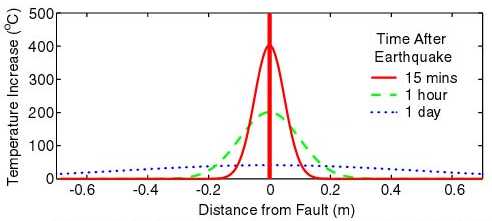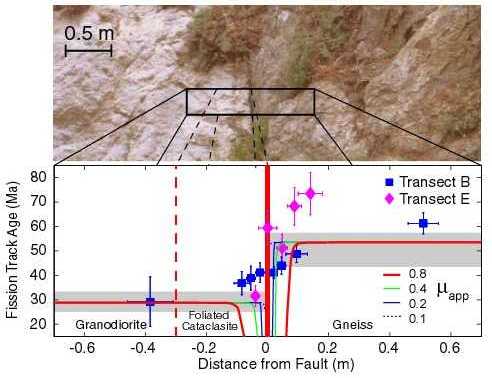No Frictional Heat on the San Gabriel fault, California:
Evidence from Fission-Track Thermochronology
Matthew A. d'Alessio, Ann E. Blythe, and Roland Bürgmann
Summary
For more than thirty years, debate has raged about the frictional strength of the San Andreas fault. If faults have the same coefficient in nature as they do at the laboratory scale, the accumulation of frictionally generated heat over geologic time should cause a significant increase in surface heat flow. Measurements of heat flow along the San Andreas do not observe any such anomaly, but there is significant concern that heat transport by fluids could easily wash away any such anomaly. In this study, we look for evidence of localized frictional heating from individual earthquakes using fission-track thermochronology. These heating events last less than a few hours and are therefore less likely to be contaminated by advective heat transport. Using two transects of fission-track samples across the San Gabriel fault, an abandoned trace of the San Andreas system, we constrain the coefficient of friction to be less than 0.4.
The figures below give a brief summary of the project, and the links at right provide detailed information.
| |
|
Links to More Detail
|
Temperature after an earthquake (below)
Using a simple model for frictional heat generation during an earthquake, we can calculate the thermal history as a function of distance from the fault. Within the first hour after the earthquake, temperatures are very high in an extremely localized region within about 10 cm of the fault. Over time, the heat pulse diffuses away by conduction.
 |
|
More About the Heat Generation Model
|

Fission Track Model v. Observations (above)
We use the thermal history calculated above to predict the effect of the quick pulse of heat on fission track ages and track lengths. The solid curves shown in the bottom panel are predicted fission track ages based on the background thermal history at the sample locality (shown in the grey bands) and heat pulses from a single earthquake with 4 m of slip on a fault with a variety of coefficients of friction (mu_app). We predict that ages should be reset to the last time the fault slipped in a narrow zone around the fault, but the data from two transects across the fault show no evidence for this reduction. Based on the location of the samples and the uncertainty in fission track age, we show that either there was never an earthquake having more than 4 m of slip at this location, or that the apparent coefficient of friction is less than about 0.4.
|
|
More About the Sample Locality
More About Fission Track Model
More About the Uncertainty in Our Conclusions
|
Read more about the project
d'Alessio, M.A., Blythe, A.E., and Bürgmann R., 2003, No frictional heat along the San Gabriel fault, California: Evidence from fission-track thermochronology: Geology, v. 31, n. 6, p. 541-544.
To honor Geology's copyright, I do not provide a direct link to an electronic copy. Please send me a quick note (dalessio@seismo.berkeley.edu) if you would like an electronic or papercopy of the manuscript .
Return to the Matthew d'Alessio's Frictional Heat page

